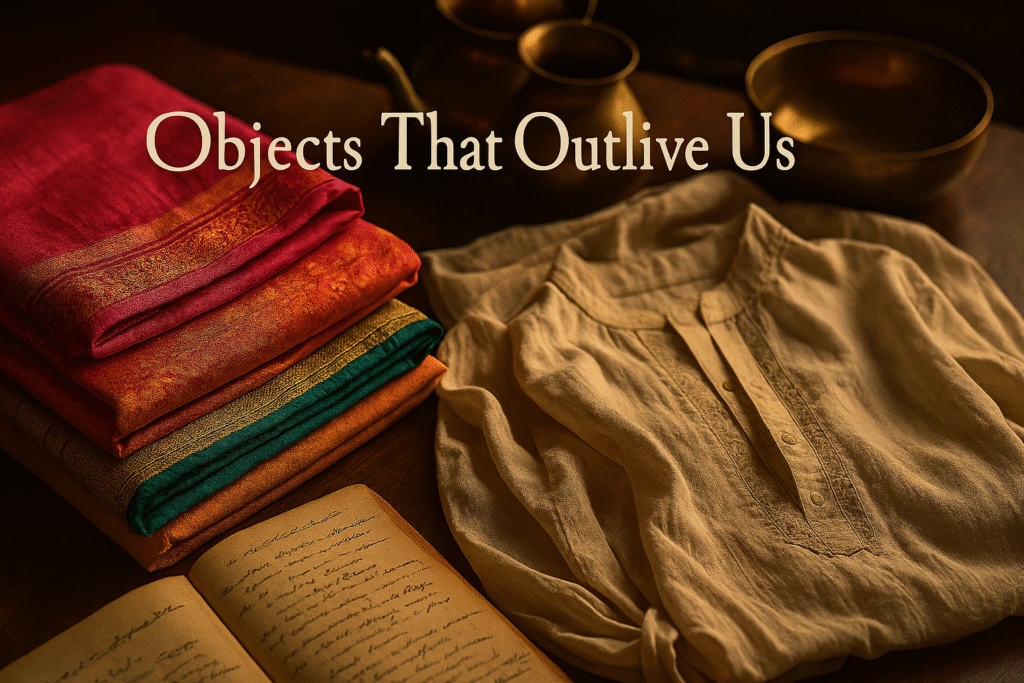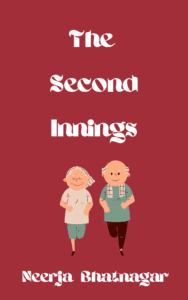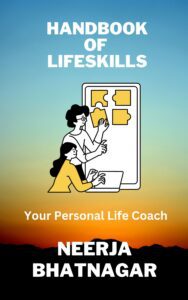
Objects That Outlive Us: Sarees, Utensils, and Kurta-Pyjamas
Some objects outlive people. They hold their breath quietly in cupboards and trunks, waiting for the hand that will touch them again, the eyes that will remember, the stories that will unfold.
When my mother passed away in 1993, I inherited not just her sarees and jewellery but also her kitchen. Her utensils, her handwritten bakery class notebook—each one became a silent bridge between her world and mine. Papa, who stayed on the first floor of our Faridabad home while my family and I lived on the ground floor, carried forward her presence in his kitchen setup, which was actually Mummy’s kitchen.
That Faridabad house saw decades of comings and goings—Ahmedabad transfers, tenants on the ground floor, returns and departures—but Maa’s kitchen always remained the soul of it. When Papa finally moved in with us, he carried along her kitchen, and it merged with mine. The Chakla belan, which I still use, is my mom’s.
Her sarees still whisper her grace. Some I kept, some I passed on to saree lovers who give old weaves a new life. Even now, when I drape one of her sarees, it feels like a conversation across time—her hand resting lightly on my shoulder.
And then there was Papa, with his endless love for clothes. After retirement, he found his style and stayed loyal to it—kurta-pyjamas. Not the plain, everyday ones, but ones he personally designed, stitched lovingly by his favourite tailor who had full liberty to play with collars, cuffs, cuts, and creativity. They weren’t just clothes; they were his second skin. He wore them daily, with a pride and comfort that made him glow.
His tailor was more than a craftsman; he was almost a collaborator. In those days, tailors were confidants—you trusted them with your measurements, your quirks, your little fashion experiments. Papa would suggest a fabric or a sleeve style, and the tailor would add a twist, a new cut, a slight flare. Together they created kurta-pyjamas that were unique, elegant, and unmistakably his.
Today, I have almost 70–75 pairs of his kurta-pyjamas. Some woollen suits have been transformed into palazzo sets for me. His footwear I gifted to his caregiver. His shirts and trousers went to others who needed them. But his kurta-pyjamas remain beautiful, stylish, timeless to me, though perhaps “out of style” in the fashion market. To me, they are not outdated; they are chapters of his story stitched in fabric.
As for Papa’s kurta-pyjamas, I often wonder what to do with them all. Some I may keep to wear on special occasions, letting his presence linger in the folds and fabric. Others could be repurposed into palazzo sets, scarves, or home décor, giving them a new life while preserving their story. A few I might gift to loved ones or share with preloved clothing communities, so the warmth of his style and memory continues to touch others. Each choice becomes a quiet way to honour him, turning these garments into living heirlooms rather than just stored fabric.
Why Objects Outlive Us
We think of objects as lifeless, but they often carry the most life. A saree remembers the warmth of the body it wrapped. A kitchen utensil holds the rhythm of hands that stirred curries and kneaded dough. A kurta, especially one designed with love, remembers the man who wore it proudly every day. These objects are not just material—they are diaries, but written without words.
In a world that rushes towards minimalism and “decluttering,” these heirlooms raise a question: should everything be given away, or should some things stay, even if they are never used?
Finding New Lives for Old Belongings
- Preloved Sarees: Giving them to saree collectors or weavers’ revival communities ensures the art lives on.
- Repurposed Clothes: Tailoring old suits into palazzos, jackets into shrugs—fashion can be memory-friendly.
- Kitchen Heirlooms: Old brass or steel utensils often last for generations. Using them keeps us grounded in sustainability.
- Handwritten Books: Recipe books, diaries, and letters deserve archiving—scan them, preserve them, or even turn them into family cookbooks.
An Invitation to You
Do you also hold on to things that belonged to your parents or grandparents? Sarees that still smell of them, utensils that still carry their touch, or clothes you don’t know what to do with?
Objects may outlive us, but they keep us alive too—inside stories, inside families, inside the quiet rituals of everyday life.
Neerja Bhatnagar
Feel free to connect with me on social media to stay updated on more content like this!
Instagram | Facebook | YouTube |Twitter |Podcast |
I have written 3 solo books and 3 anthologies. You can buy my books on Amazon. If you are on Kindle Unlimited, you can read them for free. Pls, do check and share your reviews.




This is also a tribute to your father.
Thankyou Tomichan. Yeah…